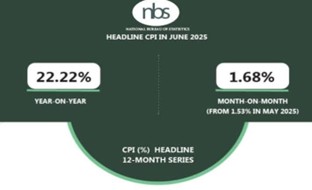Nigeria’s headline inflation rate decreased to 22.22% in June 2025, marking the second consecutive monthly decline despite persistent food price pressures that continue straining household budgets nationwide.
The National Bureau of Statistics reported the figure represents a 0.76% decrease from May’s 22.97% rate, though month-on-month inflation accelerated to 1.68% compared to the previous month’s 1.53%, indicating continued price volatility.
Food inflation remained elevated at 21.97% annually, driven by significant price increases in essential commodities including dried green peas, fresh pepper, white dried shrimps, crayfish, and meat products. These rising costs offset the headline inflation improvement, maintaining economic pressure on Nigerian families.
The year-on-year food inflation decline from June 2024’s exceptional 40.87% largely reflects the Consumer Price Index rebasing to 2024, which affects direct annual comparisons. However, the average annual food inflation rate of 28.28% for the twelve months ending June 2025 remains substantially elevated.
Economic analysts anticipate the inflation moderation could influence the Central Bank of Nigeria’s monetary policy stance when the Monetary Policy Committee convenes next week. Some experts project potential interest rate adjustments following commodity price stabilization across petroleum and agricultural sectors.
“The significant decline in the annual food inflation figure is technically due to the change in the base year,” the statistics bureau noted, cautioning against overinterpreting the improvement without considering methodological changes.
Regional variations showed urban inflation at 22.72% annually, while rural areas experienced 20.85% inflation, suggesting different economic pressures across Nigeria’s diverse geographic regions. The urban-rural inflation gap reflects varying exposure to import costs and local production capacity.
Nigeria’s Central Bank maintained benchmark interest rates at 27.50% during its May meeting, allowing policymakers to assess near-term economic developments before making adjustments. The current inflation trajectory will likely influence future monetary policy decisions.
The Consumer Price Index’s twelve-month average showed a 26.58% increase, representing a 3.42% decrease compared to the previous year’s 30.00% rate, suggesting gradual price stabilization across the broader economy. Aliyu Abdullahi Ibrahim
